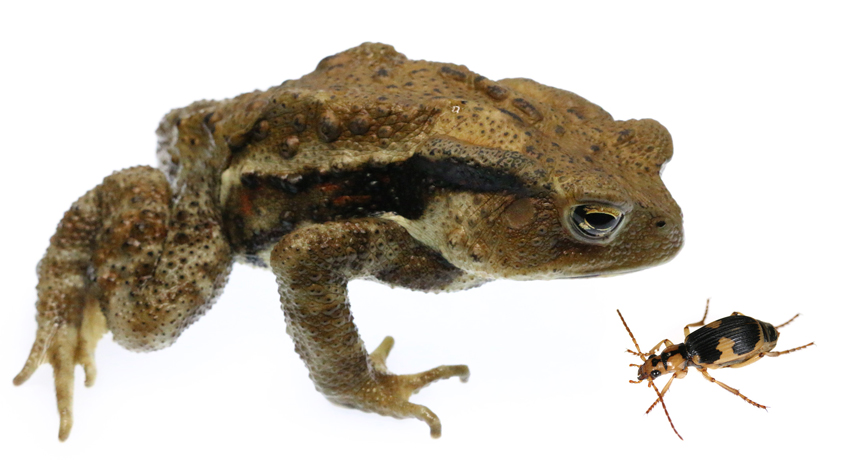Other animals besides the Sonoran Desert toad can change your mind

Last fall, the U.S. National Park Service sent out a message on Facebook asking visitors to “refrain from licking” the Sonoran Desert toad (Incilius alvarius), commonly called Bufo alvarius. This message followed a New York Times article discussing the booming interest in the psychedelic compound the toad excretes from its skin – along with the “poaching, over-harvesting and illegal trafficking” that accompany that interest.
While people don’t typically lick the toads to get high, according to Robert Villa, a community outreach specialist at the University of Arizona’s Desert Laboratory on Tumamoc Hill, ingesting the toad’s toxic secretions can cause “really dangerous side effects, like cardiac arrest.” Instead, people collect the secretions, dry and smoke them, inhaling a compound called 5-MeO-DMT, which can cause auditory and visual hallucinations. Researchers warn that the drug’s growing popularity could be detrimental to toad populations, increasing their risk of disease transmission and relocation outside their natural habitats, reducing their chances of survival.
Science News decided to explore the potential psychedelia of other animals. Join us on a tour, by land and sea, of some of the world’s mind-altering fauna.
The Sonoran Desert toad, also known as the Colorado River toad, secretes an enzyme that converts bufotenine into 5-MeO-DMT, a potent hallucinogen. Scientists aren’t sure why the Sonoran Desert toad is the only toad known to produce 5-MeO-DMT.
The giant monkey frog's toxic secretion, kambô, has been used for centuries by Indigenous populations in the southwestern Amazon as a stimulant in shamanistic rituals. While it is unclear whether it should be considered a psychedelic, a 2020 study revealed that nearly half of participants reported a spiritual experience after using kambô.
Kambô, a secretion from the skin of Phyllomedusa frogs, can cause regurgitation, seizures, and changes in heart function when predators attempt to eat them. Although researchers are still figuring out the specific compounds responsible for these effects, they do know that these frogs produce over 200 short protein fragments that can impact the body's function. Some of these fragments show promise for developing future medicines.
Habitat: Southwestern United States and northern Mexico
The venom of the California harvester ant contains enzymes that do not normally cause hallucinations, but Indigenous peoples from central California would eat them during spiritual rituals, including vision quests. Ethnographic reports suggest that people would swallow hundreds of live ants in balls of eagle down feathers, likely causing stings on the inside and triggering hallucinations. Schmidt, an entomologist, explains that a harvester ant sting is not comparable to a bee sting and the pain is intense, visceral, and accompanied by a numbing sensation. The ants use their stingers to defend themselves against large predators like lizards, birds, and humans. Regal horned lizards and some birds have their own defenses to avoid stings from the ants.
It is difficult to learn more about how Indigenous communities used these ants in rituals due to disease and violence brought by Westerners during California's gold rush, which destroyed their way of life.
Habitat: Temperate and tropical ocean waters, from the Atlantic coast of Africa to the Mediterranean Sea
Some fishes, including Sarpa salpa (sea bream), sea chubs, and clownfish, can cause visual and auditory hallucinations when eaten, although reports are rare. S. salpa was known as the "dream fish" in ancient Rome. Researchers are still trying to determine the compounds that cause this ichthyoallyeinotoxism or fish poisoning, which can also cause nightmares. Scientists suspect that these compounds are a by-product of the fishes' diets.
Ichthyoallyeinotoxism is different from other forms of fish poisoning, such as TTX produced by puffer fish's symbiotic bacteria, which can cause paralysis and death. Ciguatera fish poisoning comes from eating fish contaminated by a neurotoxin produced by some dinoflagellates and causes diarrhea, vomiting, and weakness, but does not cause hallucinations.
Habitat: The Caribbean
The pitted sponge, S. aura, and S. echina contain 5-bromo-DMT and 5,6-dibromo-DMT. These compounds are plausible psychedelics due to their relationship with the psychedelic drug DMT. The Shulgins write in TIHKAL: The Continuation that they do not know if smoking the sponge compounds activates them or not. However, these compounds can be converted into DMT by stirring them in hydrogen and methanol with palladium on charcoal.
The pitted sponge is known to concentrate in its tissue chemicals called monoamines that can modify the behavior of nerve cells. Not only can these compounds make the sponge taste bitter, but they can also alter the behavior of predatory fish that dine on the sponge.
“They wouldn’t prevent the fish from ever trying to take a bite, but it would prevent it from persisting or consuming the sponge any beyond an initial several bites,” says Mark Hamann, a pharmacologist from the Medical University of South Carolina in Charleston.
V. rigida’s ability to alter animal behavior intrigued Hamann, who reported in a 2008 study in the Journal of Natural Products that 5,6-dibromo-DMT acted like an antidepressant in rats, while 5-bromo-DMT acted like a sedative. Hamann says that related compounds may one day be isolated and might make for promising antidepressants, anxiety-reducing drugs or pain relievers in people.




